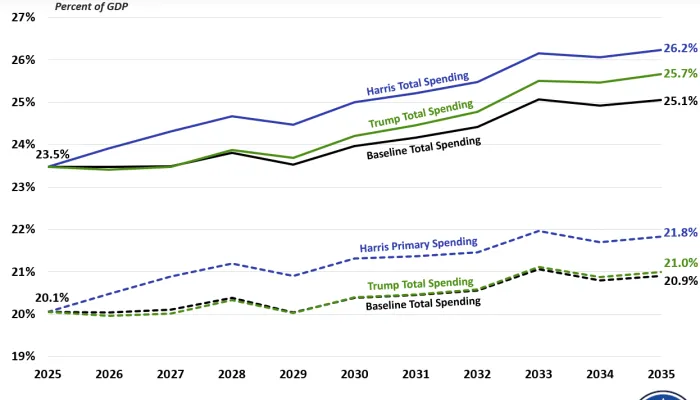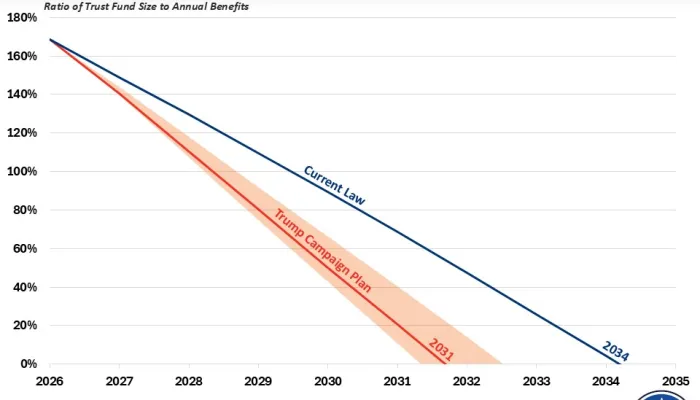Donald Trump's Proposal to Use Impoundment Authority
In a video published to his campaign website on June 20, 2023, former President Donald Trump declared he would use “impoundment” authority to reduce federal spending. Specifically, he stated:
“I will then use the president’s long-recognized Impoundment Power to squeeze the bloated federal bureaucracy for massive savings. This will be in the form of tax reductions for you. This will help quickly to stop inflation and slash the deficit.”
“Impoundment Power” refers to the ability of the President or the Executive Branch to withhold congressionally appropriated funds from their intended use. While President Trump argues this ability is “long-recognized” and “undisputed," Congress has taken definitive steps to limit presidential impoundment authority in the past, especially through the Congressional Budget and Impoundment Control Act of 1974. President Trump has argued this restriction of executive authority is unconstitutional and has vowed to challenge Congress’s limits on presidential impoundment authority in the courts.
Since President Trump has not provided details regarding which funds he would impound, we cannot provide an estimate of the effect of his proposed use of impoundment authority on the federal budget. It is also not clear that any use of impoundment would succeed when challenged in court, given laws restricting impoundment. However, it’s still important to understand what impoundment authority is, how it has been used in the past, and how President Trump is proposing to use it should he return to the White House.
US Budget Watch 2024 is a project of the nonpartisan Committee for a Responsible Federal Budget designed to educate the public on the fiscal impact of presidential candidates’ proposals and platforms. Through the election, we will issue policy explainers, fact checks, budget scores, and other analyses. We do not support or oppose any candidate for public office.
History of Impoundment Authority
While Congress holds the constitutional authority to appropriate funds and impose taxes – otherwise known as “the power of the purse” – the Executive Branch is primarily responsible for actually spending those funds for the purposes Congress intended. As head of the Executive Branch, the President is therefore theoretically in a position to intervene in that process and order agencies not to spend certain funds appropriated by Congress, but instead to either defer spending of funds or rescind them completely. This process is known as ‘impoundment.’
In the past, Presidents have used impoundment authority when Congress has appropriated funding for a purpose that is no longer relevant. For example, a commonly-cited early use of presidential impoundment authority came in 1803, after Congress appropriated funds to build 15 gunboats in response to Spain’s refusal to permit the United States access to the Port of New Orleans. Having successfully negotiated the Louisiana Purchase, President Jefferson advised Congress that the funds for the gunboats remained unspent, because the “favorable and peaceful turn of affairs on the Mississippi rendered an immediate execution of that law unnecessary."
While presidential use of impoundment authority to cancel funding was relatively rare in the nineteenth and early twentieth centuries, it became more common after the outbreak of World War II. Over the decades, Presidents began routinely using impoundment authority based on policy disagreements. This came to a head during the Nixon Administration, which by 1973 was impounding between $12 and $18 billion in congressionally appropriated funds, equivalent to between $80 and $125 billion in today’s dollars.
In order to reassert control over federal spending, Congress passed the Congressional Budget and Impoundment Control Act of 1974 (the CBA and ICA), which greatly limited the President’s ability to defer or rescind appropriated funds. Specifically, the ICA restricted the President’s ability to defer funds and provided for a congressional fast-track process for disapproving a proposed deferral. For rescissions, the ICA provides a different fast-track mechanism for Congress to approve the proposed rescission within 45 session days, or else the President must release the funds.
Since the ICA was passed, Presidents from both parties have submitted over 1,100 rescission proposals to Congress, totaling $76 billion, of which approximately 40 percent have been approved. Presidents from both parties have also advocated for changes to the ICA that would re-assert presidential authority over spending to some degree. For example, President Clinton was successful in convincing Congress to pass the Line-Item Veto Act of 1996, which amended the ICA to allow presidential rescissions from the federal budget to be effective unless Congress enacted legislation to override them. This was ruled unconstitutional by the Supreme Court two years later.
In 2019, President Trump was accused of violating the ICA by withholding $214 million in security assistance funding for Ukraine. Although President Trump did not utilize impoundment to withhold these funds, he relied on a related tool known as apportionment, which generally refers to a plan approved by the White House’s Office of Management and Budget to use budgetary resources, and in this case involved slowly releasing the funds on a schedule. Allegedly, the Trump Administration was attempting to coerce Ukraine into investigating his political opponents in the run-up to the 2020 election. This accusation, which was eventually backed by an independent ruling from the Government Accountability Office, became the premise for the House’s impeachment of President Trump in December 2019. The Trump Administration eventually released its hold on the funds in question.
How is President Trump Proposing to Use Impoundment Authority Going Forward?
On his campaign website, President Trump promises “on day one,” to “direct federal agencies to identify portions of their budgets where massive savings are possible through the Impoundment Power, while maintaining the same level of funding for defense, Social Security, and Medicare.”
Furthermore, President Trump makes very clear his intention to “challenge the constitutionality of the limits placed on the Impoundment Power by the Congressional Budget and Impoundment Act of 1974.” This suggests he intends on using impoundment authority in a way the ICA forbids, preventing congressionally appropriated funds from being used for purposes with which he disagrees.
What’s less clear, however, is what President Trump would do with those deferred or rescinded funds. On one hand, he claims his use of impoundment authority would reduce deficits and slow inflation. Indeed, reducing deficit spending would have a disinflationary effect, assuming deferred or rescinded funds were not used for other purposes. On the other hand, President Trump also suggests deferred or rescinded funds would be used to pay for tax breaks or to strengthen Social Security and Medicare, negating any deficit reduction.
As more details are released, we will provide further analysis.
*****
Throughout the 2024 presidential election cycle, US Budget Watch 2024 will bring information and accountability to the campaign by analyzing candidates’ proposals, fact-checking their claims, and scoring the fiscal cost of their agendas.
By injecting an impartial, fact-based approach into the national conversation, US Budget Watch 2024 will help voters better understand the nuances of the candidates’ policy proposals and what they would mean for the country’s economic and fiscal future.
You can find more US Budget Watch 2024 content here.


